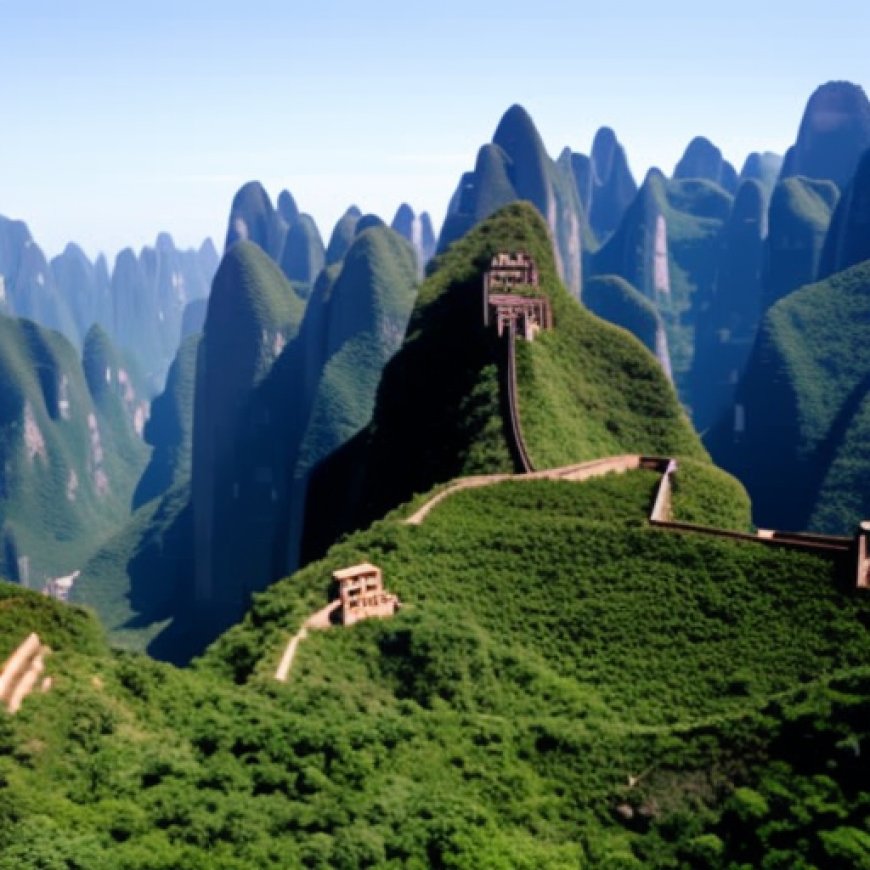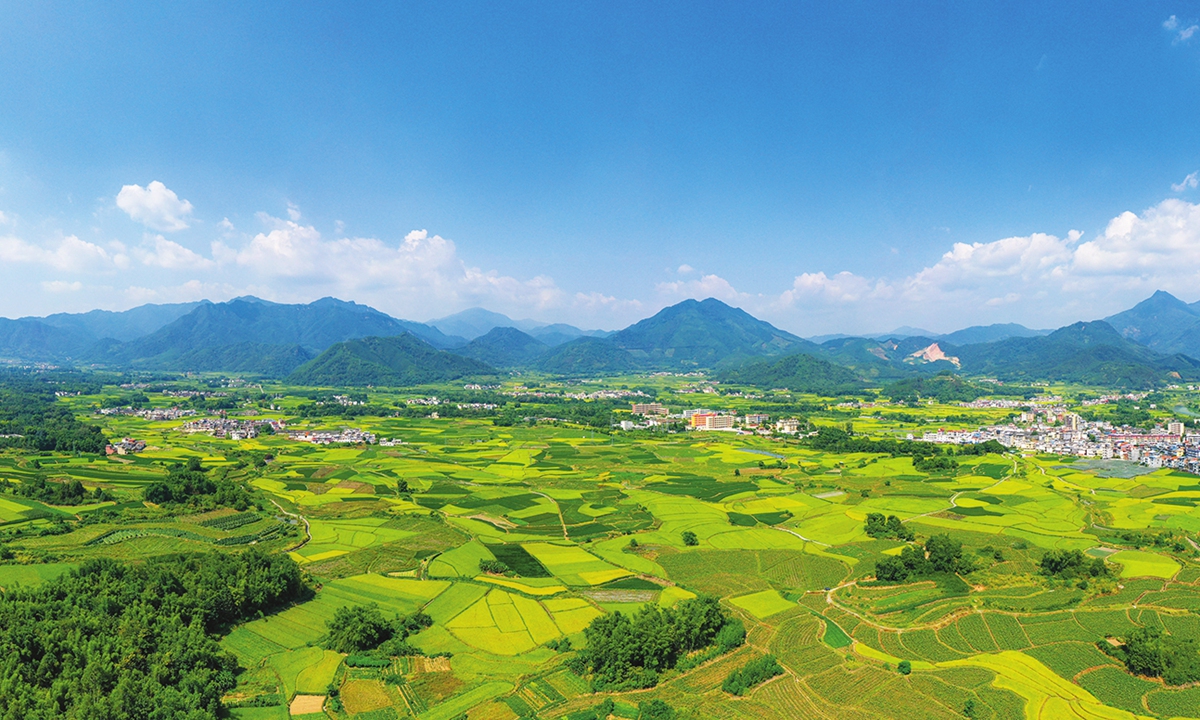China’s ecological civilization inspires Africa in green development
China's ecological civilization inspires Africa in green development Global Times


Building a Beautiful China: Implications for Developing Countries

Photo: VCG
Editor’s Note: Building a Beautiful China plays a huge part in building a great modern socialist country and advancing national rejuvenation. At a recent national conference on ecological and environmental protection, Chinese President Xi Jinping said China should support high-quality development with a high-quality ecological environment and promote modernization featuring the harmonious co-existence between human and nature. From a participant in global environmental governance to a leader, China’s achievements in the development of ecological civilization have been remarkable, and they have become even more prominent as mankind faces greater challenges such as the global climate crisis. The Global Times selected the opinions of international observers on China’s ecological civilization and its implications for developing countries.
China’s Ecological Civilization and its Implications for Developing Countries
As the second-largest economy in the world, China’s ecological civilization comes with many best practices for the African continent and other developing countries in the Global South.
It is feasible, profitable, and sustainable to modernize through economic policies and strategies that promote harmonious co-existence between human and nature.
- China’s Five Key Pillars for Sustainable Development
Over the past decade, China’s high-quality sustainable development has increasingly been built upon five key pillars:
- Innovation
- Coordination
- Green
- Opening-up
- Sharing
These pillars serve as a foundation for China’s success in ecological civilization and can serve as a model for other developing countries.
- Foregrounding Ecological Value for Economic Growth
As China and Africa rapidly expand their economic partnerships, the African continent has a front-row seat on how foregrounding ecological value is a catalyst, not an impediment, to economic growth.
China’s major forestry projects serve as an example for African countries to combat the effects of climate change and ensure sustainable economic growth.
- Economic Development without Ecological Destruction
China is showing Africa that economic development is not synonymous with ecological destruction. By integrating nature and social economy into the development path, China proves that economic growth can coexist with environmental sustainability.
Africa can learn from China’s success and develop a green industrialization revolution that prioritizes sustainability.
- China’s 14th Five-Year Plan
China’s 14th Five-Year Plan provides a roadmap for Africa to achieve high-quality development in various aspects, including the economy, environment, and people’s livelihood. It offers guidance for Africa to integrate into the global industrial chain and value chain.
- Inspiring Green Mobility
China’s leadership in electric mobility inspires African countries to shift towards a less carbon-intensive transportation model. Projects like the China-built electric-powered light rail in Nigeria’s Lagos demonstrate the potential for sustainable infrastructure development.
- Ecological Conservation as a Building Block
China’s recognition and respect for nature, evident in its national policies for conserving natural resources and protecting the environment, serve as a potent tool for building an ecological civilization. This convergence of values between China and Africa can guide the continent towards sustainable growth.
- China’s Green Policies: Development and Environmental Protection
China’s green policies demonstrate that development and environmental protection are not mutually exclusive. By addressing climate change and promoting economic growth simultaneously, China sets an example for other countries to follow.
- China’s Influence in Global Environmental Governance
China’s influence in global environmental governance, particularly among its partners in the Global South, is growing. Africa has the opportunity to reshape its approach to development in line with China’s successful model of ecological civilization.
The author is a Kenya-based journalist. opinion@globaltimes.com.cn
SDGs, Targets, and Indicators
| SDGs | Targets | Indicators |
|---|---|---|
| SDG 7: Affordable and Clean Energy | 7.2: Increase the share of renewable energy in the global energy mix | No specific indicators mentioned in the article |
| SDG 8: Decent Work and Economic Growth | 8.4: Improve resource efficiency in consumption and production | No specific indicators mentioned in the article |
| SDG 9: Industry, Innovation, and Infrastructure | 9.4: Upgrade infrastructure and retrofit industries to make them sustainable | No specific indicators mentioned in the article |
| SDG 11: Sustainable Cities and Communities | 11.3: Enhance inclusive and sustainable urbanization and capacity for participatory, integrated, and sustainable human settlement planning and management | No specific indicators mentioned in the article |
| SDG 12: Responsible Consumption and Production | 12.2: Achieve sustainable management and efficient use of natural resources | No specific indicators mentioned in the article |
| SDG 13: Climate Action | 13.1: Strengthen resilience and adaptive capacity to climate-related hazards | No specific indicators mentioned in the article |
| SDG 15: Life on Land | 15.2: Promote the implementation of sustainable management of all types of forests | No specific indicators mentioned in the article |
| SDG 17: Partnerships for the Goals | 17.6: Enhance North-South, South-South, and triangular regional and international cooperation on and access to science, technology, and innovation | No specific indicators mentioned in the article |
1. Which SDGs are addressed or connected to the issues highlighted in the article?
- SDG 7: Affordable and Clean Energy
- SDG 8: Decent Work and Economic Growth
- SDG 9: Industry, Innovation, and Infrastructure
- SDG 11: Sustainable Cities and Communities
- SDG 12: Responsible Consumption and Production
- SDG 13: Climate Action
- SDG 15: Life on Land
- SDG 17: Partnerships for the Goals
2. What specific targets under those SDGs can be identified based on the article’s content?
- SDG 7.2: Increase the share of renewable energy in the global energy mix
- SDG 8.4: Improve resource efficiency in consumption and production
- SDG 9.4: Upgrade infrastructure and retrofit industries to make them sustainable
- SDG 11.3: Enhance inclusive and sustainable urbanization and capacity for participatory, integrated, and sustainable human settlement planning and management
- SDG 12.2: Achieve sustainable management and efficient use of natural resources
- SDG 13.1: Strengthen resilience and adaptive capacity to climate-related hazards
- SDG 15.2: Promote the implementation of sustainable management of all types of forests
- SDG 17.6: Enhance North-South, South-South, and triangular regional and international cooperation on and access to science, technology, and innovation
3. Are there any indicators mentioned or implied in the article that can be used to measure progress towards the identified targets?
No specific indicators are mentioned or implied in the article that can be used to measure progress towards the identified targets.
4. SDGs, Targets, and Indicators
| SDGs | Targets | Indicators |
|---|---|---|
| SDG 7: Affordable and Clean Energy | 7.2: Increase the share of renewable energy in the global energy mix | No specific indicators mentioned in the article |
| SDG 8: Decent Work and Economic Growth | 8.4: Improve resource efficiency in consumption and production | No specific indicators mentioned in the article |
| SDG 9: Industry, Innovation, and Infrastructure | 9.4: Upgrade infrastructure and retrofit industries to make them sustainable | No specific indicators mentioned in the article |
| SDG 11: Sustainable Cities and Communities | 11.3: Enhance inclusive and sustainable urbanization and capacity for participatory, integrated, and sustainable human settlement planning and management | No specific indicators mentioned in the article |
| SDG 12: Responsible Consumption and Production | 12.2: Achieve sustainable management and efficient use of natural resources | No specific indicators mentioned in the article |
| SDG 13: Climate Action | 13.1: Strengthen resilience and adaptive capacity to climate-related hazards | No specific indicators mentioned in the article |
| SDG 15: Life on Land | 15.2: Promote the implementation of sustainable management of all types of forests | No specific indicators mentioned in the article |
| SDG 17: Partnerships for the Goals |








